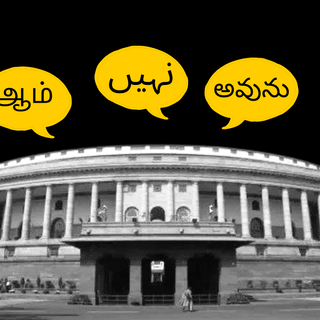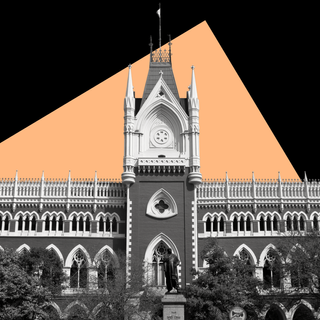
For Women at the Farmers’ Protests in Delhi, the Farming Laws Aren’t the Only Issue
Even as women unite to protest the three controversial farming laws, they struggle for leadership and land ownership, and against casteism.

On the morning of 18 January 2021, the sun shines through smoke at Tikri Kalan, a stretch at the border of Delhi and Haryana where one of the farmers’ sit-ins against the three Farm Acts is located. It is Day 54 since farmers began the original sit-in at Singhu, in Delhi, after months of agitation against the laws. At 10 a.m., if you follow the stream of people sidestepping the police barricades, you find your way to the stage where Jasbir Kaur, a longtime activist for farmers’ rights and part of the Samyukta Kisan Morcha — the umbrella organisation of farmers’ unions in India — is addressing the crowd. Facing her is a sea of women bundled up in colourful shawls and caps. Above them, metro trains rattle by on the track.
The birthplace of the Green Revolution in the 1960s, Punjab has been subject to increasing corporatisation and diminishing state subsidies. Today, perhaps it is only natural that this new agricultural “revolution” is being powered out of the state. And that women are playing a leading role.
But not everyone agrees. During hearings on the ongoing farmers protests, the Chief Justice of India, S.A. Bobde asked why women and elders had been “kept” in the protest, adding the need to “persuade” them to return. This now-infamous comment betrays a startling lack of awareness considering women constitute 42% of the agricultural labour force, and 73.2% of rural women are involved in farming. It was met by an equally paternalistic reassurance, from advocate A.P. Singh, that the women and elders would not be participating further due to the cold and pandemic.
At Tikri and Singhu, any evidence of this claim looks scant. It is Women Farmers Day (in part, a direct response to the CJI’s remarks), and women are everywhere — from a troupe of little girls waiting to perform karthi, spiky silver mace in hand, to brisk volunteers with lathis and green ‘A woman’s place is in revolution’ stickers on their jackets distributing water to grandmothers in the audience. Periodically, refrains of ‘Aurat komal hai, kamzor nahi’ ‘Women are soft, not weak’ ring out from speakers at both sites, alongside informed take-downs of GST, demonetisation, Adani and Ambani.
“The comments of the SC show its foundation in Manusmriti, which is both casteist and anti-woman. We have been seeing this agenda of the RSS percolate into governance for a long time now,” says Panjab University PhD student Harpreet Kaur, 32. Harpreet grew up in Mandi Kalan village, Rampura, near Mansa, with the shadow of farmer suicides heavy upon her psyche. “Women aren’t at the protests just for their husbands, sons or grandsons. Their role isn’t just to make rotis or wash clothes, it’s about occupying that space themselves.”
Navikran Natt, 30, daughter of Jasbir Kaur, emphasises the loaded histories the women bring with them. “My mother herself comes with 30 years of activism, she’s been arrested in the movement to implement the 33% share of common land due to Dalits in the village. I’ve been part of worker unions right from university. We haven’t suddenly appeared here in Delhi out of thin air. Each of us has our own histories of struggles.”
***
A 2017 state survey on agricultural suicides in six districts of Malwa — most impacted by the agrarian crisis in Punjab — reported that three farmers died by suicide per day between 2002 and 2015. 83% of suicides were due to debt; most families did not receive government compensation. This pattern holds true across India. According to the latest data released by the National Crime Records Bureau, 10,281 farmers died by suicide in 2019 alone.
“Our definition of farmer is so limited — it excludes women, Adivasis, mazdoors (labourers).”
Women across India are left behind to shoulder bereaved, debt-ridden farming families. Ranjana Padhi’s research on women after farmer suicides in Malwa illuminates the mental burden of fatherless families and poverty. Further, as multiple women protestors point out, women’s economic activities, which include tending to livestock, harvesting, and sowing, are not counted as formal labour.
Only 13.87% of rural women own land, per the 2016 Agricultural Census. On paper, daughters inherit family land equally, but it’s not applied in practice, Navkiran says. This umbrella of sexism enables a narrative of universality about the women protesters that still doesn’t capture the many divisions and struggles within the farming protest — movements within movements within movements.
“Our definition of farmer is so limited — it excludes women, Adivasis, mazdoors (labourers),” Natt says.
Dalits, who constitute 32% of Punjab’s population, own only 2.3% of the agricultural land and work largely as marginal or landless labourers. The new farm laws would hit them hardest as it leaves them at the mercy of large corporates. Thus, mazdoor unions and Ambedkarite organisations too support the protests. However, enduring contestations around caste and women’s rights continue.
This is evident in casual assertions of caste-pride like “Humare bhi zameenein hai, hum bhi Jatt hai” (I also work on the land, I am a Jatt, too), as Revanti, of Kalana Mandi in Hissar, tells me at Singhu, alongside privileged declarations that “Kisan kisan hota hai” (Farmers are farmers — we don’t look at caste here).
Agricultural families from the struggling Malwa region are the ones who have congregated at the Tikri border. In comparison, many at Singhu are from a more prosperous land-owning class. Jats, who make up 25% of Punjab, own the majority.
“I don’t know who is Dalit, who is upper-caste,” says Suman Hooda, 40, a cultural promoter from Khokha, Hisar, in Haryana. “If you want to talk to someone, I can ask them, but they might be insulted.” When pushed on matters of representation, she admits that people dependent on daily-wage labour for survival may not be able to come here to “do leadership.” While younger women like Nakiran and Harpreet bring up caste struggles predating the protests, this is mostly elided elsewhere.
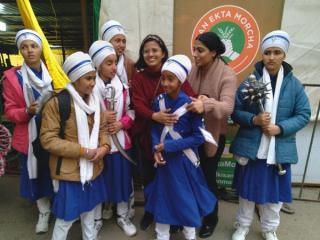
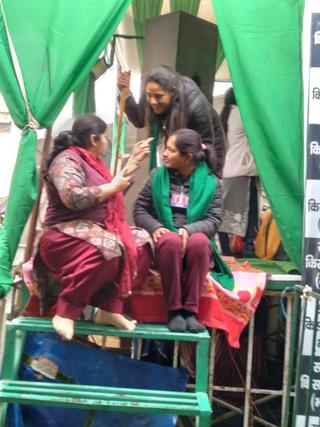
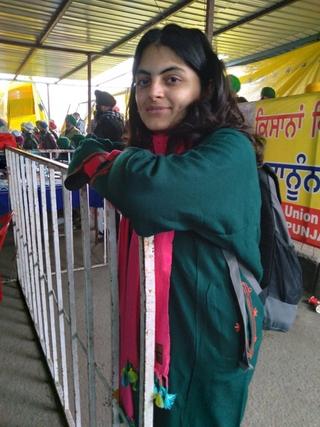
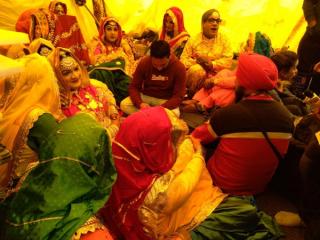

Clockwise, from top left: Protestors Kanupriya and Raman speak with a dance troupe performing at the Women Farmers Day rally at Singhu. Women talk backstage on Day 54 of the farmers’ protest at Singhu. Protestor Navikran Natt, 30, at the Women Farmers Day rally on Day 54 of the farmers’ protest in Singhu. Women wait backstage at the Women Farmers Day rally at Singhu. Women protestors gather before a stage at Tikri Kalan on Day 54 of the farmers’ protest.
Images Credit: Riddhi Dastidar
Strikingly, “kisan ki beti” — “farmer’s daughter” — is a popular refrain. This is emblematic of two things: first, that even women who do agricultural labour are often hesitant to claim the label of farmer; and second, that much of the younger generation does not pursue agriculture. If a family can send its children to pursue upward mobility outside of farming — an increasingly precarious occupation — it’s almost certain that they will. Still, they feel deep ties to the land and farming. Here at the protests, such young women do critical work.
Navkiran is one of two women in the team behind the Trolley Times, the on-site newspaper, Trolley Talkies (film screenings), and the Shaheed Bhagat Singh Library. “People are hungry to know more about the policies we’re fighting, the histories of struggles in the past, like the Ghadar movement,” she says. “Popular culture is a powerful tool of resistance and we’re going to use it.”
Related on The Swaddle:
In Shaheen Bagh, Muslim Women Redefine Carework as Resistance
At Singhu, Navjot Kaur, 23, the daughter of mazdoors in Pitthu village, Rampura, holds informal classes for children from slum areas around the protest site. Kanupriya, 25, sees the protest as an opportunity for little girls to have their first exposure to feminist spaces and thoughts.
Ramanpreet Kaur, 29, from Bhatinda, is on unpaid leave from work. Backstage at Singhu, she says proudly, “I’ve been here from Day 1.” She had planned to volunteer with Khalsa Aid in Punjab, but from there she jumped on a bus to Delhi. She only told her father after she had reached. Here, she is involved in a plethora of tasks: arranging food supplies, langar, and mapping the locations of elders who need medication and warm clothes.
“There are hundreds of things we’re doing right now — jo bhi milta hain, just jump into it!”
***
Protests are seldom built for women. Many at Singhu and Tikri Kalan are on their period when I meet them. The small portable washrooms lining the protest sites are not enough for their large numbers, and in the mornings there are long lines. Even during the Women Farmers Day program, Kanupriya has a tussle with a man who is intent on claiming the stage.
Despite the divisions within the movement, there is a unanimous undercurrent among protesting women that this is where they must be, this is what they must do. And no amount of persuasion or paternalism in the world will change their minds about staying “up to 365 days,” one woman says matter-of-factly — until the three kaale kaanoon are repealed.
The current situation is undeniably bleak — with more than 70 deaths, many of which are suicides, that protesters call “murders for which the government is solely responsible.”
“When I was in Bhatinda watching the videos of people here, the indifference of the government — I just kept feeling helpless. Aake mujhe thodi tasalli ho gayi (I got a little relief by coming here). If there are elders staying in these difficult conditions, in the freezing cold, then at least I am here too, helping out,” Ramanpreet explains.
Despite the uncertain future, the women of the farmers protests are here — giving it their all to shape the protests to their needs and towards the liberatory futures they dream of with their hard-won agency.
Ramanpreet tells me, “I can’t do more than this. Whatever I can do I’m already doing.”
Riddhi Dastidar is a writer and researcher in Delhi who works on disability justice, gender, climate, and culture. They lead "Sound, Fury & 4G," a longread series on technology, gender, and development for the rural feminist media house, Khabar Lahariya. They are also a mental health reporting fellow with IndiaSpend. In 2020, they won the TFA award for poetry. Follow them on @gaachburi everywhere.
Related


Bombay HC Says it Will Hold Media in Contempt If Reporting Is Biased Against Police, Accused
